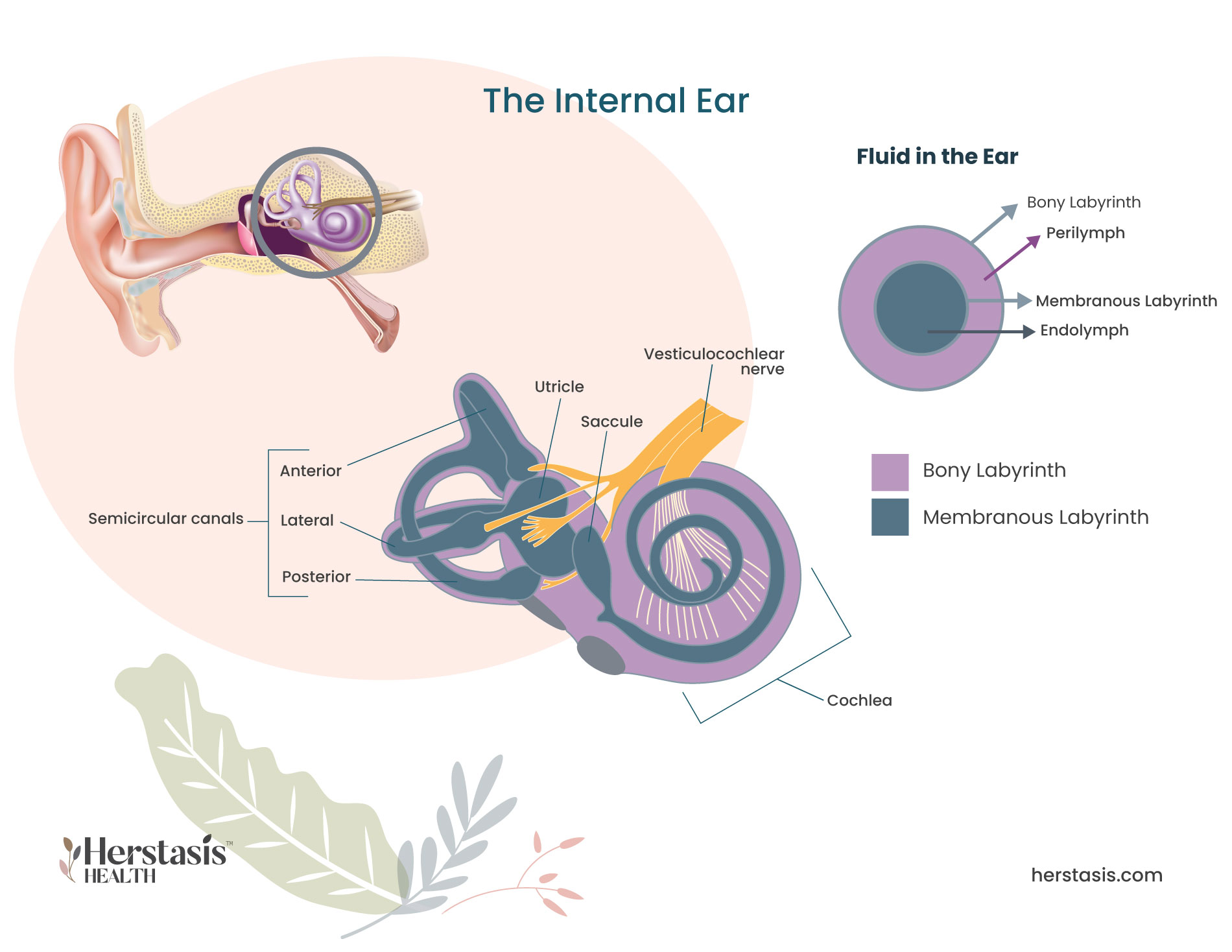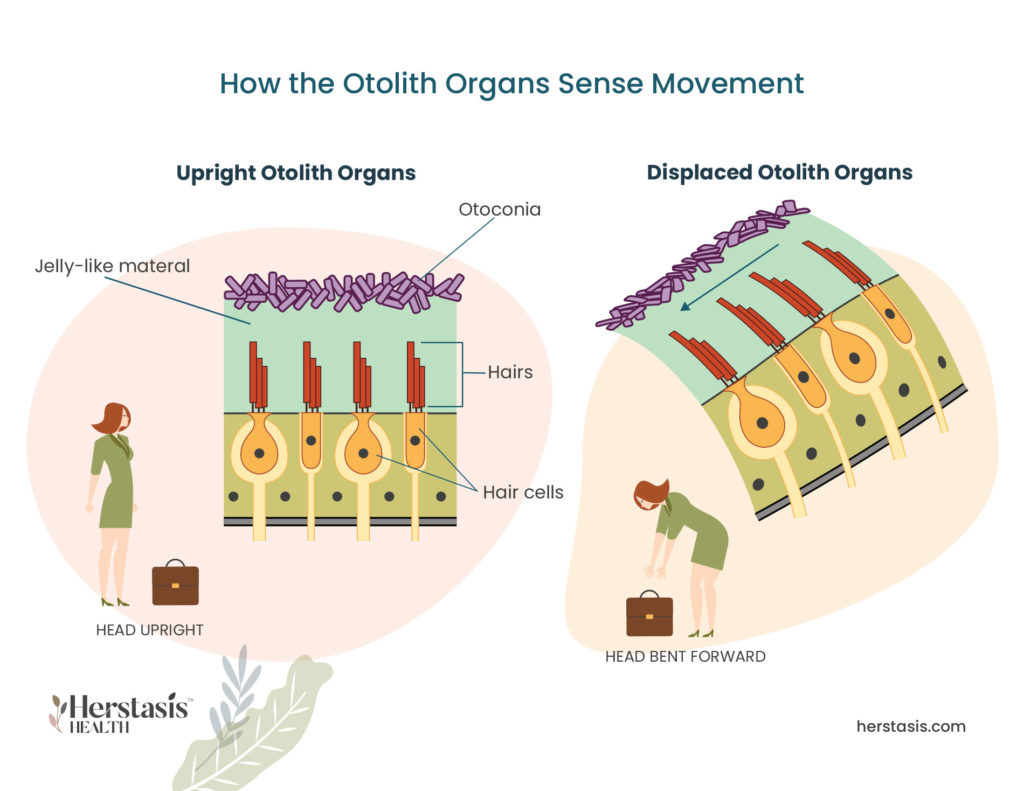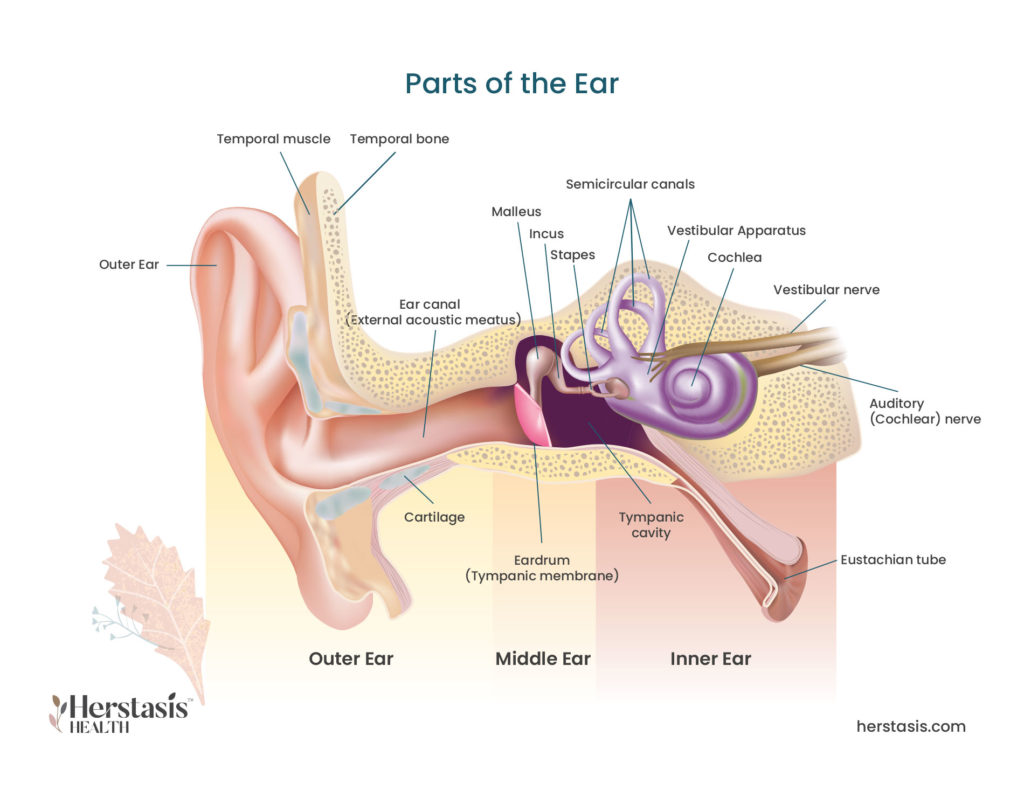What are Dizziness and Vertigo?
Dizziness is the term used to describe sensations of lightheadedness, unbalanced, or “wooziness”. Vertigo is a specific type of dizziness that causes you to feel that you or the world around you is spinning or moving. Dizziness and vertigo can start or become worse when you stand up or move your head quickly, and in some cases you may also feel nauseous. Episodes of dizziness can be short and sudden, or may last for hours. Dizziness can often re-occur.
Dizziness and vertigo are symptoms, not conditions on their own. Finding the specific cause of dizziness and vertigo is difficult, and typically involves a process of elimination. Hormonal changes are thought to play a role in some cases of dizziness and vertigo, and hot flashes and dizziness may happen at the same time. However, little research has looked at this directly and for now, there is no direct causal link between hormonal fluctuations and dizziness or vertigo. [1] [2]
There are multiple causes of dizziness and vertigo including inner ear problems and circulatory problems, and dizziness and vertigo are also associated with insomnia, hot flashes, migraines, stress and anxiety. [1] [2] [3] [5]
Self-care & Natural Remedies for Dizziness and Vertigo
Dizziness and Vertigo are symptoms, which means that self-care may help reduce the impact or frequency of their occurrence, but these self-care options are unlikely to address the underlying issue.
Recording when, how, and for how long you experience these episodes can be very helpful when you discuss your dizziness and vertigo with your healthcare provider. There are multiple possibilities about the cause of your dizziness.
- Your head is not receiving enough oxygenated blood, which can make you light-headed and dizzy. This can happen from a sudden drop in blood pressure if you sit or stand up too quickly, called orthostatic hypotension. Poor blood circulation can also be a cause and can happen for many different reasons, including irregular heartbeats or cardiomyopathy, which is a condition of the heart muscle.
- Medications such as blood pressure lowering medications, anti-seizure drugs, antidepressants, sedatives or tranquilizers may cause faintness as a side effect.
- Neurological conditions, such as Parkinson’s disease and multiple sclerosis, can lead to loss of balance that progresses over time. [3] [4]
- Stay hydrated.
- Maintain steady blood sugar levels by eating more frequent small meals and healthy snacks. Including complex carbohydrates, such as whole grains and vegetables is helpful as these are broken down more slowly in your body, helping to maintain balanced blood sugar instead of peaks when you eat and lows before your next meal.
- Follow a regular sleep schedule and go to bed and rise at the same time every day. Dizziness is associated with insomnia so good sleep hygiene can be helpful.
- Find effective ways to manage your stress and anxiety. This can be achieved through regular exercise, meditation, or yoga. Seek counseling or therapy if you need help with severe or ongoing stress and anxiety.
- Practice balancing exercises to help strengthen the muscles involved in supporting your balance. [4]
If you experience any recurrent, sudden, severe, or prolonged and unexplained dizziness or vertigo, inform your healthcare provider. Emergency medical care is needed if you experience new episodes of severe dizziness or vertigo along with any of the following:
- Sudden, severe headache
- Chest pain
- Difficulty breathing
- Numbness or paralysis of arms or legs
- Fainting
- Double vision
- Rapid or irregular heartbeat
- Confusion or slurred speech
- Stumbling or difficulty walking
- Ongoing vomiting
- Seizures
- A sudden change in hearing
- Facial numbness or weakness. [3]
Therapy & Treatment for Dizziness and Vertigo
At age 40 find a reliable, educated primary care provider familiar with recognizing and treating symptoms of perimenopause and menopause. The North American Menopause Society provides a list of menopause practitioners here.
Dizziness usually corrects itself without treatment, however, if you are suffering regular and/or intense episodes of dizziness you should see your healthcare provider. Seeking the cause of dizziness and vertigo is often a process of elimination. You will probably have to undergo hearing and balance tests so your healthcare provider can assess how you walk and maintain your balance. A simple head-movement test, called the Dix-Hallpike test, is the gold standard for diagnosing benign paroxysmal positional vertigo (BPPV). Posturography, where you stand on a platform in bare feet and try to keep your balance as the platform moves, gives information about how your balance system is functioning. Blood tests can indicate if there are any infections present. [3]

The Science

The body system responsible for our sense of balance and for awareness of our body position (spatial awareness or spatial orientation) is called the vestibular system. Our balance and awareness of our positioning in the world allows us to make split second adjustments to respond to internal and external forces. For example, if you miss a step or if a gust of strong wind blows against you, it is your vestibular system that corrects your position and (sometimes) allows you to keep your balance.
The vestibular system has two parts: the central system, made up of the brain and brainstem, and the peripheral system, made up of the inner ear.
The inner ear, also known as the bony labyrinth, is located in a cavity (called the otic capsule) of the temporal bone. It is a bony structure made up of two main parts: the cochlea (which is responsible for your hearing) and the vestibular apparatus (which is responsible for maintaining balance and spatial awareness). The vestibular apparatus contains three semicircular canals that detect angular motion (like turning your head) and two sac-like structures, the utricle and saccule (together called otolith organs) , which detect straight-line or linear movements. [6] [7]

Each otolith organ contains hair cells with hairs that are embedded in a jelly-like material. On top of the jelly are small crystals called otoconia, much like sprinkles on top of ice cream. The otoconia, commonly called “ear rocks,” sense gravity. If the ear rocks separate from the jelly and fall into one of the semicircular canals, which can happen when the position of your head changes quickly, this sends incorrect information about gravity to your brain, causing benign paroxysmal positional vertigo (BPPV).
The semicircular canals do not sense gravity, but they do sense movements along a straight line – up, down, and sideways. The 3 canals are oriented roughly 90 degrees to each other (in the same way that the 3 sides of a box are all oriented 90 degrees relative to each other from a corner of the box) and each canal contains multiple hair cells. When these hair cells move with straight line motion (back and forth or up and down), because of the orientation of the canal they are in, they allow your brain to identify the direction and size of any head movements.
Inside the bony labyrinth, suspended in a fluid called perilymph, is another chamber called the membranous labyrinth and it contains a fluid called endolymph. You can visualize this as one hose filled with fluid inside another hose filled with fluid. The fluids inside both of the labyrinths contain sodium and potassium, but in different ratios. If the ratios change or become unstable for some reason (for example with a condition such as Meniere’s disease), this can result in vertigo, dizziness, nausea, plugged ears or tinnitus. [6] [7]

Myths & Mysteries
FALSE
There are many different problems that can result in the feeling of vertigo. The inner ear is the most common, but other issues including medication side effects, stress, hormonal changes, or high blood pressure can also cause vertigo. [8]
MYTH
Not true. Acrophobia is the technical name for having a fear of heights. It can happen if you are up a ladder or look out of a window in a tall building, and it can also be a debilitating disorder if you have serious acrophobia. Acrophobics may have the sensation of vertigo when they are having a stress response to being high up, but vertigo can come from many different causes.[8]
FALSE
Vertigo has multiple other symptoms that usually happen at the same time as the sensation of spinning. These include nausea, vomiting, sweating, headache, changes in your hearing, tinnitus, loss of your balance and the sensation that you are being pulled sideways. [8]
MYTH
Not true. The terms vertigo and dizziness are often used interchangeably, but their symptoms and their causes are different. Typically dizziness makes you feel like your head is spinning, and vertigo makes you feel like the world is spinning around you or the floor beneath your feet is tilting. [8]
Citations
[1] Terauchi M, Odai T, Hirose A, Kato K, Akiyoshi M, Masuda M, Tsunoda R, Fushiki H, Miyasaka N. Dizziness in peri- and postmenopausal women is associated with anxiety: a cross-sectional study. Biopsychosoc Med. 2018 Dec 12;12:21. doi: 10.1186/s13030-018-0140-1. PMID: 30559834; PMCID: PMC6291970.
[2] https://vestibular.org/article/coping-support/living-with-a-vestibular-disorder/hormones
[3] https://www.mayoclinic.org/diseases-conditions/dizziness/symptoms-causes/syc-20371787
[4] https://www.medicalnewstoday.com/articles/319860
[7] https://emedicine.medscape.com/article/883956-overview
[8] https://www.southernent.com/blog/myths-and-facts-about-vertigo







